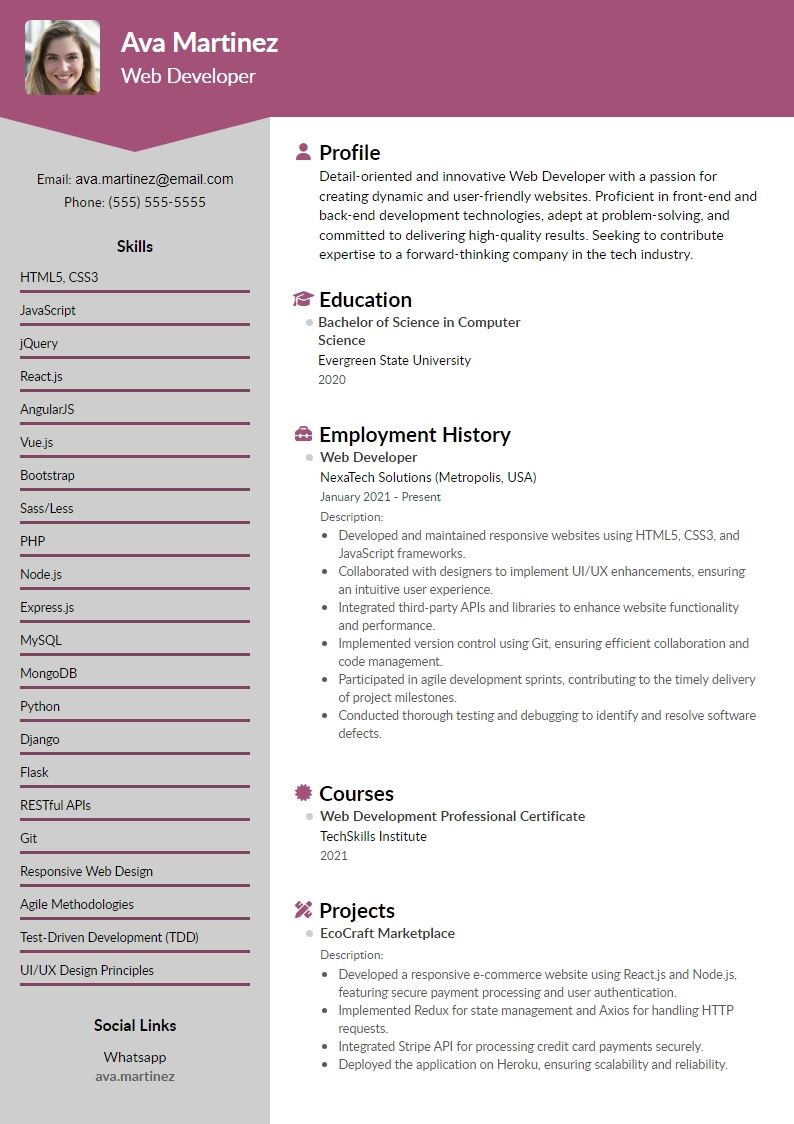Web Developer Resume Example
How to Write a Web Developer Resume
In today's highly competitive job market, a well-crafted resume can make all the difference in landing your dream job as a web developer. Your resume is often the first impression you make on potential employers, so it's crucial to ensure that it effectively showcases your skills, experience, and qualifications. Here are some essential tips and guidelines to help you create an outstanding web developer resume:
-
Choose the Right Format: Start by selecting the appropriate resume format that highlights your strengths and experiences. For most web developers, a chronological or combination resume format works best. This format allows you to showcase your work experience, skills, and achievements in a clear and organized manner.
-
Tailor Your Resume: Customize your resume for each job application by carefully reviewing the job description and incorporating relevant keywords and skills. Highlight your most relevant experiences and accomplishments that align with the specific requirements of the position you're applying for.
-
Include a Strong Summary or Objective: Begin your resume with a compelling summary or objective statement that briefly outlines your skills, experience, and career goals. This section should grab the recruiter's attention and entice them to continue reading your resume.
-
Highlight Your Technical Skills: As a web developer, technical skills are crucial. Create a dedicated section to showcase your proficiency in programming languages, frameworks, tools, and technologies relevant to web development. Be specific and include both front-end and back-end skills, such as HTML5, CSS3, JavaScript, React.js, Node.js, etc.
-
Showcase Your Projects: Your projects demonstrate your practical experience and abilities as a web developer. Include a section where you can highlight relevant projects you've worked on, along with a brief description of each project, the technologies used, and your role in the development process. If possible, provide links to live websites or GitHub repositories.
-
Quantify Your Achievements: Whenever possible, quantify your achievements to provide concrete evidence of your impact. For example, mention the number of websites you've developed, the percentage increase in website traffic, or any cost savings or efficiency improvements you've implemented.
-
Emphasize Soft Skills: In addition to technical skills, soft skills are also essential for success as a web developer. Highlight your communication skills, problem-solving abilities, teamwork, and adaptability. Employers value candidates who can effectively collaborate with team members, communicate ideas clearly, and adapt to changing project requirements.
-
Keep it Concise and Relevant: Your resume should be concise, typically no longer than one or two pages. Focus on including relevant information that directly relates to the job you're applying for. Avoid including unnecessary details or irrelevant experiences that may distract from your qualifications.
-
Proofread and Edit: Before submitting your resume, thoroughly proofread it to ensure there are no spelling or grammatical errors. Pay attention to formatting, consistency, and overall readability. Consider asking a friend or colleague to review your resume for feedback and suggestions.
-
Update Regularly: Finally, remember to regularly update your resume with new skills, experiences, and achievements as you progress in your career. Keep it current and relevant to increase your chances of success in the job market.
In conclusion, a well-written web developer resume is essential for securing job opportunities in the competitive tech industry. By following these tips and guidelines, you can create a compelling resume that effectively showcases your skills and experiences, ultimately helping you stand out to potential employers. Good luck!
